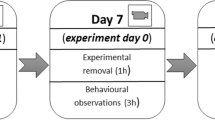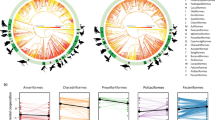Summary
In a species with biparental care two parents cooperate to provide the appropriate amount of care for the young. Recent theoretical treatments consider the evolutionarily stable investment strategy. Under most conditions, the parental investment of the two partners should be negatively correlated, with the shortfall of one partner being partially compensated for by the other. Previous experimental manipulations of biparental care have involved removal of one partner, yet the response of a widowed bird may differ from that of a mated bird whose partner is doing less than its fair share of parental care. We present the first data involving subtle manipulations of sex differences in parental care where both partners continue to care for the young. This study involves pairs in a nestbox colony of european starlings (Sturnus vulgaris L.) with all brood sizes manipulated to five chicks. Pairs were randomly assigned to three groups: (i) male parental care reduced; (ii) female parental care reduce; and (iii) control pairs. Parental care was manipulated by attaching small weights to the base of a bird's tail feathers. Regardless of sex, nest visitation rate was reduced in the weighted birds with an incomplete compensatory increase by their unweighted partner. Additional parental duties were also considered, including shifts in prey type delivered to the nest, in both weighted birds and their partners. The shift in diet and the overall lower total visitation rate in experimental nests contributed to slower chick growth and lower chick weights than in control nests. The data accord with models suggesting that equality of invesment in biparental species is evolutionarily stable, but reveal new dimensions of parental response that need to be taken into account in theoretical treatments.
Similar content being viewed by others
References
Alatalo R, Lundberg A, Stahlbrandt K (1982) Why do pied flycatcher females mate with already mated males? Anim Behav 30:585–593
Alatalo RV, Gottlander K, Lundberg A (1988) Conflict or cooperation between parents feeding nestlings in the pied flycatcher Ficedula hypoleuca (Pallas). Ornis Scand 9:31–34
Bengtsson H, Rydén O (1983) Parental feeding rate in relation to begging behaviour in asychronously hatched broods of the great tit Parus major. Behav Ecol Sociobiol 12:243–251
Breitwisch R (1988) Sex differences in defence of eggs and nestlings by the northern mockingbird, Mimus ployglottos. Anim Behav 36:62–72
Brown JL, Dow DP, Brown FR, Brown SD (1978) Effects of helpers on feeding of nestlings in the grey-crowned babbler, Pomatostomus temporalis. Behav Ecol Sociobiol 4:43–59
Brown JL, Brown ER, Brown SD, Dow DD (1982) Helpers: effects of experimental removal on reproductive success. Sci 215:421–422
Chase ID (1980) Cooperative and noncooperative behavior in animals. Am Nat 115:827–857
Coulson JC (1966) The influence of pair bond and age on the breeding biology of the Kittiwake Gull Rissa tridactyla: J Ani Ecol
Dhondt AA, Hublé J (1968) Fledgling date and sex in relation to dispersal in young great tits. Bird Study 15:127–134
Drent DH, Daan S (1980) The prudent parent: energetic adjustments in avian breeding. Ardea 68:225–252
Feare C (1984) The starling, OUP, Oxford
Gessaman JA, Nagy KA (1988) Transmitter loads affect the flight speed and metabolism of homing pigeons. Condor 90:662–668
Greenlaw JS, Post W (1985) Evolution of monogamy in the seaside sparrow Ammodramus maritimus: test of hypotheses. Anim Behav 33:373–383
Haartman von L (1967) Clutch size in the pied flycatcher. Proc XIV Intern Ornithol Congr:155–164
Hand DJ, Taylor CC (1987) Multivariate analysis of variance and repeated measures. Chapman and Hall, London
Harris MP (1971) Ecological adaptation of moult in some British gulls. Bird Study 18:113–118
Houston AI, Davies NB (1985) The evolution of cooperation and life history in the dunnock, Prunella modularis. In: Sibly R, Smith R (eds) Behavioural ecology: the ecological consequences of adaptive behaviour. Blackwell, Oxford, pp 471–487
Kacelnik A (1984) Central place foraging in starlings (Sturnus vulgaris). I. Patch residence time. J Anim Ecol 53:283–300
Kacelnik A, Cuthill IC (1987) Starlings and optimal foraging theory: modelling in a fractal world. In: Kamil, AC, Krebs, JR, Pulliam HR (eds) Foraging behavior. Plenum, New York, pp 303–333
Kluijver HN (1950) Daily routines of the great tit, Parus major L. Ardea 38:99–135
Kluijver HN (1970) An experimental study of the survival of young great tits. Abstract of paper read at XV Intern Ornithol Congr:661
Lack D (1968) Ecological adaptations for breeding in birds. Chapman and Hall, London
Lefelaar D, Robertson RJ (1986) Equality of feeding roles and the maintenance of monogamy in tree swallows. Behav Ecol Sociobiol 18:199–206
Lifjeld JT, Slagsvold T (1988) Effects of energy costs on the optimal diet: an experiment with pied flycatchers Ficedula hypoleuca feeding nestlings. Ornis Scand 19:111–118
Lyon BE, Montgomerie RD, Hamilton LD (1987) Male parental care and monogamy in snow buntings. Behav Ecol Sociobiol 20:377–382
Merkel FW (1980) Sozialverhalten von individuell markierten Staren — Sturnus vulgaris — in einer kleinen Nistkastenkolonie. Die Rolle der Polygynie. Luscinia 44:133–158
Møller AP (1988) Paternity and paternal care in the swallow, Hirundo rustica. Anim Behav 36:996–1005
Nisbet ICT, Drury WH (1972) Post-fledgling survival in herring gulls in relation to brood size and date of hatching. Bird Banding 43:161–172
Perrins CM (1965) Population fluctuation and clutch size in the great tit Parus major. J Anim Ecol 34:601–647
Perrins CM (1968) Survival of young manx shearwaters Puffinus puffinus in relation to their presumed date of hatching. Ibis 108:132–135
Pinxten R, Elsacker L Van, Verheyen R (1986) Observations on polygyny in the starling (Sturnus v. vulgaris). In: Drickamer LC (ed) Behavioural ecology and population biology. Privat, IEC, Toulouse, pp 77–82
Rydén O, Bengtsson H (1980) Differential and locomotor behaviour by early and late hatched nestlings affecting the distribution of food in asynchronously hatched broods of altricial birds. Z Tierpsychol 53:209–224
Sargent RC, Gross MR (1985) Parental investment decision rules and the concorde fallacy. Behav Ecol Sociobiol 17:43–45
Sasvari L (1986) Reproductive effort of widowed birds. J Anim Ecol 55:553–564
Silver R, Andrews H, Ball GW (1985) Parental care in an ecological perspective: a quantitative analysis of avian subfamilies. Am Zool 25:823–840
Skutch AF (1976) Parent birds and their young. Univ Texas Press, Austin
Smith HG, Källander H, Fontell K, Ljungström M (1988) Feeding frequency and parental division of labour in the double-brooded great tit Parus major. Effects of manipulating brood size. Behav Ecol Sociobiol 22:447–453
Sokal RR, Rohlf FJ (1981) Biometry. 2nd ed. Freeman and Co., New York
SPSS Inc (1986) SPSSx users' guide, 2nd ed. SPSS Inc, Chicago
Studd MV, Robertson RJ (1985) Sexual selection and variation in reproductive strategies in male yellow warblers (Dendroica petechia). Behav Ecol Sociobiol 17:101–109
Tinbergen JM (1981) Foraging decisions in starlings. Ardea 69:1–67
Trivers RL (1972) Parental investment and sexual selection. In: Campbell B (ed) Sexual selection and the descent of man, 1871–1971. Aldine Press, Chicago, pp 136–179
Verbeek NAM, Morgan JL (1980) Removal of primary remiges and its effect on the flying ability of glaucous-winged gulls. Condor 82:224–226
Ward JG (1973) Reproductive success, food supply and the evolution of clutch size in the glaucous-winged gull. Ph.D. diss. Univ. British Columbia, Vancouver
Westerterp K, Gortmaker W, Wijngaarden H (1982) An energetic optimum in brood-raising in the starling (Sturnus vulgaris), an experimental study. Ardea 70:153–162
Winkler DW (1987) A general model for parental care. Am Nat 130:526–543
Wittenberger JF, Tilson RL (1980) The evolution of monogamy: hypotheses and evidence. Ann Rev Ecol Syst 11:197–232
Author information
Authors and Affiliations
Rights and permissions
About this article
Cite this article
Wright, J., Cuthill, I. Manipulation of sex differences in parental care. Behav Ecol Sociobiol 25, 171–181 (1989). https://doi.org/10.1007/BF00302916
Received:
Accepted:
Issue Date:
DOI: https://doi.org/10.1007/BF00302916




